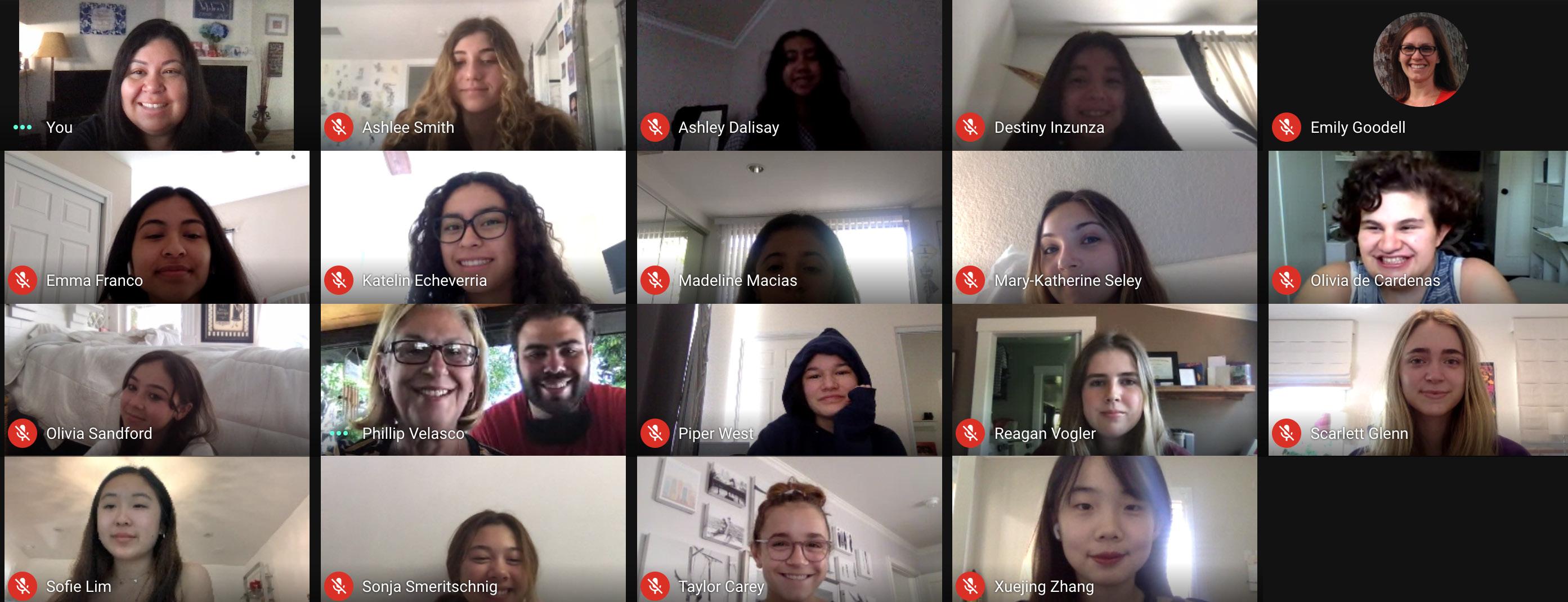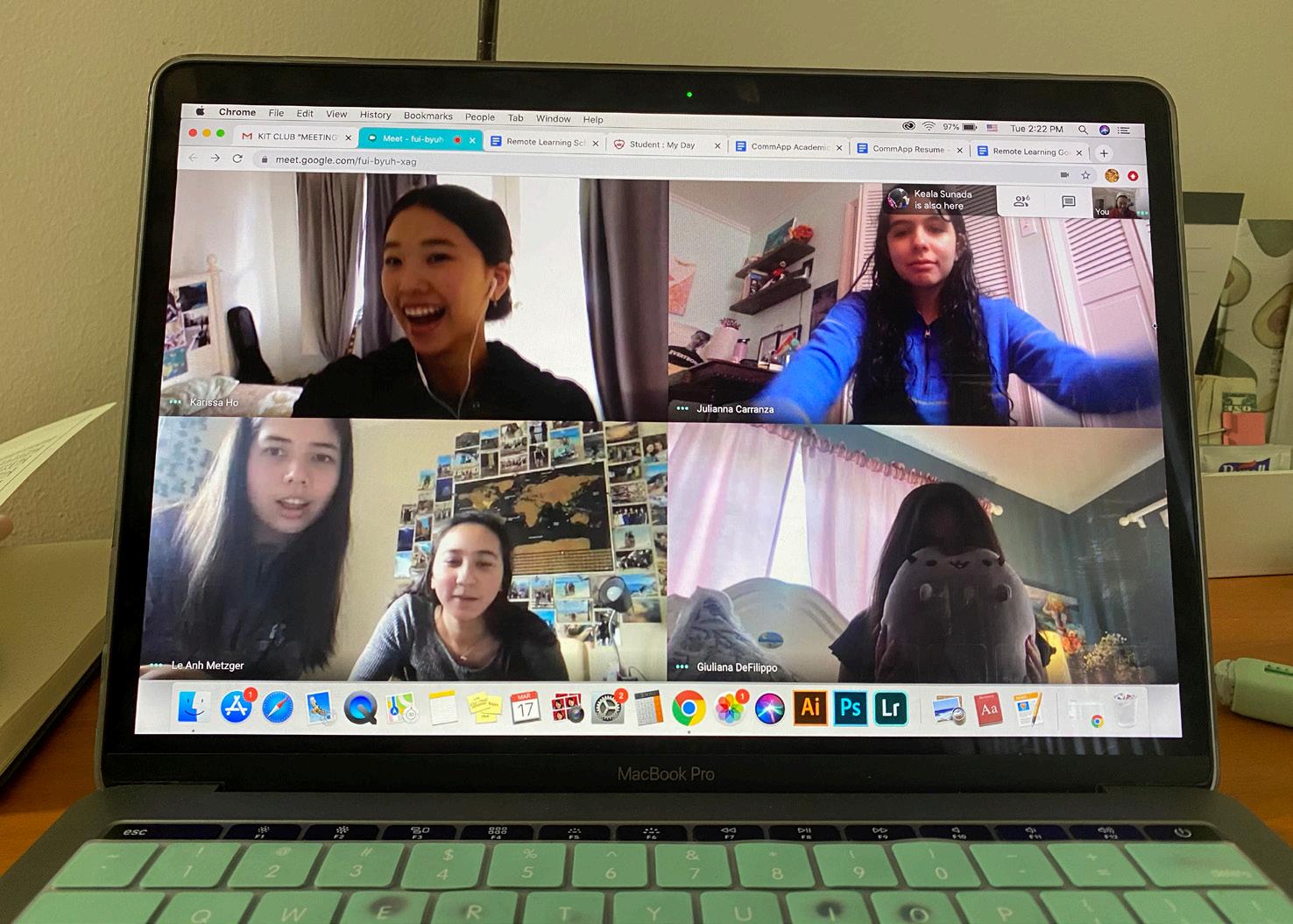
7 minute read
How Holy Child Teaching Keeps the Human Connection Alive in Virtual Classrooms
Cheerful, responsible, flexible, hopeful, conscientious, resilient. This is how Mayfield teachers described their students during our trialby-fire immersion in remote learning. And, as consummate role models of our “Actions Not Words” motto, Mayfield teachers also embraced this unexpected educational adventure with positivity and resolve.
When Cornelia Connelly asked Holy Child educators to “meet the wants of the age,” she could never have imagined the kind of classes our students attended this year. Students and teachers logged into virtual classrooms from their bedrooms, living rooms and kitchens. They wore their sweats, brought their pets, and exchanged smiles and words of encouragement on their laptop screens.
Advertisement
For teachers, the transition to “working from home” wasn’t as simple as firing up a Google Meet session and plowing through business-as-usual classwork. There was a lot of creative teaching and learning going on, and it was all based on the relationship of mutual trust and respect that Holy Child teachers work to build with each of their students.
Although they regularly incorporate educational technology into their coursework, many were nervous about taking their lessons completely online. Teachers had just over a week to come up with a robust remote lesson plan for their students and then hit the ground running in their virtual classrooms. “If you’d asked me in September, ‘How about teaching your class online?’ I’d have said, ‘Are you kidding me?’, ” said world history teacher Sr. Pegeen Connolly, SCRH. After two months of 100% web-based instruction, Sr. Pegeen is proud of her own adaptability, which was inspired in part by the conscientious, cheerful attitudes of her ninth-grade students.
Despite minor tech mishaps, like accidentally muted microphones or split-screen snafus, our teachers learned—very quickly—how to translate the Holy Child educational philosophy into a virtual classroom setting. They did singalongs, moderated online group discussions, and used Flipgrid, Nearpod and Jamboard to create interactive experiences. “It was an opportunity, which was exciting, to explore different ways of learning,” said theology teacher Ron Castelo.

As part of a unit on the Cold War, these sophomore history students heard first-hand experiences from Ana Velasco, Technical Director Phillip Velasco’s mom, who immigrated to California from Cuba in the early 1960s. Before their online meeting, students “really took to the challenge of doing their reading and research,” said Ms. Garcez.
For the first week, in a bid to maintain a semblance of instructional continuity, students continued with their regular school-day schedule on screen. But soon, WiFi woes, screen fatigue, and social isolation began to take their toll. Something had to change. The schedule was quickly reinvented to address the concerns of Mayfield students, parents and teachers. Being in a Holy Child School “helped us to pivot and to be open and flexible,” said Dean of Faculty and AP Government teacher Tina Zapata. “We really put the students’ needs first and met them where they were.”
The revised four-day schedule included shorter, 60-minute classes, longer breaks between blocks and “Wellness Wednesday,” a completely offline day that was a huge hit with both teachers and students. Students used the midweek screen-free day to recharge and catch up on homework and assignments.
But it’s difficult to mirror the energy of a Mayfield classroom online. “It’s just not the same when we can’t be in the same room,” said math teacher Annie Pontrelli, who found talking to an on-screen grid of faces “quite lonely.” Social studies teacher Anne Hartfield ’77 agreed that she’s also looking forward to resuming lively in-class conversations with her students. “I’ve missed the chattiness and the classroom energy,” Dr. Hartfield said, a sentiment echoed by math instructor Emily Baratta Goodell ’99, who said she now appreciates the deeply collaborative nature of her regular “interactive, student-led” geometry classroom even more.
“There are things one sees live that you simply can’t see online, and relationships that form in person that don’t form remotely,” explained Sr. Pegeen. “Those observations and relationships make teaching more effective and meaningful.”
Students wholeheartedly agree. “I think such a big part of the Mayfield educational experience is the spirit of collaboration, communication and community, but that spirit is kind of lost over a Google Meet call,” said Karissa Ho ’21.
So, Mayfield teachers have found solutions. As they pursued new ways to share their curriculum, teachers became students again, too. After an initial educational technology boot camp, where they learned step-by-step ways to maximize tech tools in their new online classrooms, many faculty members spent their spring break taking webinars and looking for online activities to boost interaction and keep the sense of connection alive in their virtual classes.
Creative workarounds
Math Department Chair Melissa Tighe found that online breakout rooms, where students could engage in small group work like they would in class, were a game changer. “Students want to bond and work with each other,” Mrs. Tighe said. “And this also promotes having students work with different people than the ones they may have limited themselves to.” And Mr. Castelo was impressed by his students’ enthusiastic participation in online discussion boards, an activity he plans to weave into class even when oncampus learning eventually resumes.
English teacher Julie Sanchez Brehove ’11 encouraged her ninthgrade students—and their pets—to commemorate the first day of remote learning with an attendance selfie, and she was gratified by the results. “We had a lot of animal friends, and we even had some screen collaboration between some of the students,” Mrs. Brehove said. “They’re still fostering community, even from afar!”
For many teachers, lesson pacing was another puzzle to solve in their transition to a remote classroom. “It took a bit of thought and trial-and-error to work out how to get to the essentials so that the students learned what they needed to but also weren’t exhausted,” Sr. Pegeen said. Dr. Hartfield, who teaches AP U.S. History, had to streamline her curriculum, which she said meant “letting go of some of the course content and thinking about what lessons were really important.” Ms. Pontrelli agreed, saying, “I’ve definitely had to restrategize and reprioritize.”
Although Ms. Pontrelli said she missed her students, she did notice that self-paced study had a silver lining: building independent learners. She’s seen many students become more assertive and more self-motivated during their months of remote learning, and, “In the long run, these are traits which will help them persevere when things get tough,” she said.

Students have also taken the initiative to support each other in forums like impromptu peer tutoring groups. “We made group chats and we would just be like, ‘Does anyone need help?’, ” said Alexa Valenzuela ’22. “We all knew we were in this together, and we still are all in this.”
Some teachers took advantage of the flexible class schedule to make oneon-one meetings a priority. Ms. Pham actually found more time to shepherd each of her English students through the writing process, going back and forth over drafts together via video call. “This is difficult to facilitate during the hectic school day of a regular year,” she said. “It was such a gift to be able to work so closely with students, especially in a time that otherwise felt very distant for all of us.”
There were creative workarounds, too, for subjects that just don’t translate well online, especially those that usually meet in the lab or the studio. Chemistry students improvised an at-home pH test with domestic staples like NaCl and H 2 O (aka salt and water), the fine arts department shipped care packages to visual arts students so they had studio tools at their fingertips, and performing arts students produced many quarantine video collaborations (see page 27).
A few teachers were even able to use the pandemic as a touchstone for their coursework. Suddenly, previously theoretical concepts had real-world relevance. For example, Mrs. Tighe said the ubiquitous charts predicting the spread of the coronavirus “certainly illustrate the tools we teach in calculus for advanced graphical and data analysis.”
And sophomore English students were able to inject new insight into their analysis of Lisa See’s historical novel Snow Flower and the Secret Fan, which partly takes place during the typhoid epidemic in 19th-century China. “It was illuminating to read this chapter with the eyes of someone who has lived through a pandemic herself,” said Ms. Pham.
Confronting life-and-death issues in their day-to-day lives, Mr. Castelo said, also prompted some students to delve into deeper dimensions of learning. “Students were forced to ask the big questions in life—the essential questions in theology,” he said.
Resuming with resilience
The 2020-21 school year will continue with the modified four-day schedule. In a recent online survey, many Mayfield students said that they enjoyed the flexibility of online classes and the ability to work at their own pace, and more than half the students who responded reported that their wellbeing—including sleep, exercise and eating habits—had improved during their time at home. But the vast majority of the student body said that being separated from their friends and teachers has been the toughest trial.
We’re all looking forward to hallway hellos, hugs and high-fives one day—but in the meantime, Mayfield faculty will continue to find innovative online ways to leverage the deep human connections that are the foundations of Holy Child education.
“Nothing is a perfect substitute for in-person learning, but the final two months of school this year were a time of remarkable growth for our entire community, both academically and personally,” said Ms. Pham.
Mrs. Goodell had this message for Mayfield parents: “Thank you for raising such independent, resilient daughters!”











